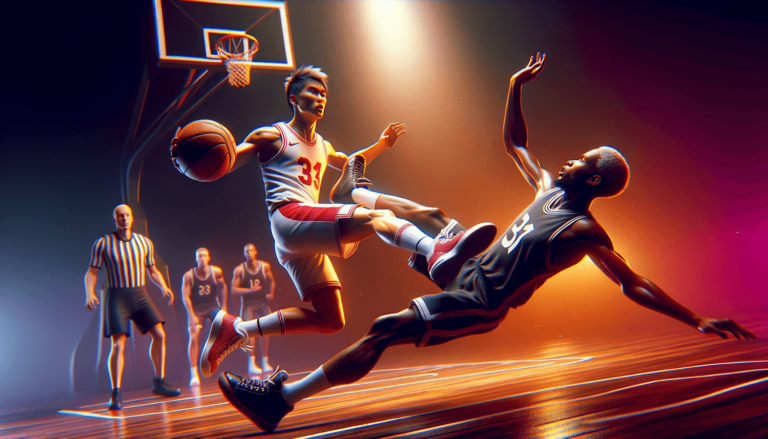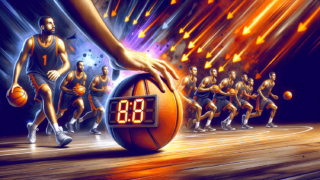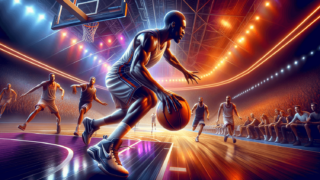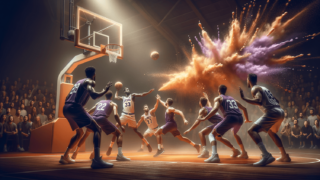
Kick Ball Violation in Basketball: Rules and Interpretations
Written by: Basketball Universe
Last updated:

As basketball enthusiasts, we know that understanding the ins and outs of the game is crucial to fully enjoying every swish, slam dunk, and fast break. In this blog post, we’re going to explore one of the lesser-known rule violations: the kick ball. While it might not make headlines like flashy plays or buzzer-beaters, this aspect of the game is just as essential to ensuring fairness and maintaining the flow of the game. So, strap in, grab your whistles and referee handbooks, and let’s dive into the mysterious world of kick ball violations in basketball: their rules, interpretations, and how they impact the game we all love!
Kick Ball Violation in Basketball: Rules and Interpretations
A kick ball violation in basketball occurs when a player intentionally or deliberately strikes the ball with their leg or foot. This rule aims to prevent players from gaining an unfair advantage by using their lower limbs to control the ball. When a kick ball violation is called, the opposing team is awarded the ball for a throw-in from the nearest out-of-bounds spot. However, if the ball accidentally touches a player’s leg or foot without intent, no violation is called, and the game continues.
Understanding the Kick Ball Violation Fundamentals
Before diving into the nitty-gritty of kick ball violations, it’s essential to first have a solid foundation in the basic principles of basketball rules. The kick ball violation, although not as widely discussed, is a fundamental rule that every basketball enthusiast should understand to fully appreciate the sport’s intricacies. Here, we will break down the essential elements of the kick ball violation, why it’s in place, and how it’s implemented in the game.
Intentional vs. Accidental Contact
A crucial aspect of the kick ball violation is differentiating between intentional and accidental contact with the ball using your leg or foot. Referees must determine whether a player purposefully used their lower limb to control the ball (committing a violation) or if the ball accidentally struck their leg or foot (play continues without a violation).
Though it may sound like a challenging judgement call, experienced referees usually utilize various factors to make their decisions, such as the player’s body position and movement in relation to the ball. If the referee determines the player’s action to be deliberate, they will call a kick ball violation.
The Origins and Purpose of the Kick Ball Rule
The kick ball violation rule dates back to the early days of basketball when the sport was still in its infancy. The primary goal of this rule is to maintain the integrity and spirit of the game by preventing players from gaining an unfair advantage using their legs or feet, turning basketball into a sport focused on each player’s predominantly upper body skills.
Moreover, the kick ball rule promotes a smooth flow of the game by avoiding an erratic play style where players might be constantly kicking the ball to advance it up the court or disrupt the opposing team’s offense. In essence, the rule upholds basketball’s core principles by enabling the players to showcase their skills with their hands, arms, and shooting abilities.
Kick Ball Violation in Different Basketball Leagues
It’s crucial to note that different basketball organizations and leagues worldwide adapt and interpret the kick ball violation rule in their respective rulebooks. Though the central premise of the rule is consistent from league to league, understanding the subtle nuances and interpretations for each governing body will help enthusiasts appreciate the sport beyond just the NBA.
National Basketball Association (NBA)
In the NBA, the rulebook clearly states that a kick ball violation occurs when a player “intentionally strikes the ball with any part of the leg.” Consequently, players must refrain from using their legs or feet to control, pass, or block the ball. If the referee calls a kick ball violation, the opposing team is awarded a throw-in from the nearest out-of-bounds spot, with the shot clock reset to either 14 seconds or its original value, whichever is greater.
International Basketball Federation (FIBA)
FIBA’s rules are closely aligned with the NBA’s when it comes to kick ball violations. Indeed, FIBA states that a player is in violation if they “deliberately kick the ball or block it with a foot or leg.” However, a noteworthy difference in FIBA rules is the shot clock reset protocol – the shot clock is either reset to 14 seconds, remains the same, or continues its countdown, depending on the specific situation and time remaining.
National Collegiate Athletic Association (NCAA)
Similar to the NBA and FIBA, the NCAA also enforces the kick ball violation rule. However, the NCAA offers a slightly more detailed definition in their rulebook, stating that a violation occurs when a player “intentionally uses any part of the leg from the foot to the knee to strike or pin the ball to the floor, causing it to go out of bounds or to be touched by another player.” If a kick ball violation occurs, the shot clock is reset to 20 seconds or its original value, whichever is greater.
Common Misinterpretations and Myths about Kick Ball Violations
Over the years, many misconceptions and myths have surrounded the kick ball violation rule, leading to confusion for players, fans, and even referees. Here, we aim to clarify some of these misunderstandings and provide a better insight into this unique aspect of the game.
Does the Ball Have to be “Kicked” for a Violation?
One common misperception is that a violation can only occur if a player actively “kicks” the ball. However, that is not the case. According to basketball rules, a kick ball violation occurs if a player intentionally uses any part of their leg or foot to gain an advantage or control the ball, whether or not they physically “kick” it.
Can a Kick Ball be Called on a Loose Ball?
Another widely misunderstood concept is that a kick ball violation can only be called if a player is in possession of the ball. That, too, is incorrect. A kick ball violation can be called during any part of the game, including when players are competing for a loose ball, as long as a player intentionally uses their leg or foot to control the ball.
Are Blocked Shots and Deflections Kick Ball Violations?
Many fans believe that a kick ball violation can be called whenever the ball makes contact with a player’s leg or foot. However, that is not the case. If a player unintentionally blocks a shot, deflects a pass, or strikes the ball with their leg or foot without intent, there is no violation, and the game continues as if no such contact occurred.
Strategies Related to Kick Ball in Basketball
As rare as it may seem, the kick ball violation presents some strategic opportunities to benefit teams when executed under select circumstances. Although it’s not commonly seen as an intentional move, incorporating the kick ball violation into a team’s overall playing strategy could yield surprising advantages at crucial moments in a game.
Leveraging Kick Ball to Reset the Shot Clock
Every team needs to devise clever tactics to deal with opponents who are dominant on both offense and defense. One such approach to consider is using the kick ball violation to reset the shot clock, providing a limited opportunity to regroup and execute a new offensive play. But coaches must keep in mind that such moves are risky and can backfire, leading to unfavorable outcomes.
Disturbing the Opposing Team’s Rhythm
Exploiting a kick ball violation at opportune moments may give a team a chance to disrupt its opponents’ offensive flow or their fast-break momentum. While many may perceive this as a desperate move, experienced coaches might recognize its potential in influencing an opponent in critical game situations.
Playing Within the Rules: Avoiding Kick Ball Violations
For both players and teams, adhering to the rules is paramount to achieving success on the court. When it comes to avoiding kick ball violations, maintaining discipline and awareness can significantly impact a game’s outcome. To consistently stay within the bounds of basketball rules, players should consider the following:
Body Positioning and Footwork
Having correct body positioning on the court, especially when playing defense or handling loose balls, is essential. Anticipating plays and focusing on footwork helps players avoid unnecessary leg or foot contact with the ball, thereby steering clear of potential kick ball violations.
Mental Discipline and Sportsmanship
An essential aspect of any sport is mental discipline, and this is true for basketball as well. Players should develop a strong in-game mindset and sportsmanship, which will undoubtedly contribute to avoiding unnecessary penalties, such as kick ball violations, and improve their overall game performance.
Consistent Practicing and Training
Purposeful and focused practice, featuring a variety of drills and exercises, fine-tunes a player’s instincts and develops their ability to make split-second decisions on the court. Incorporating such training helps players avoid mistakes and penalties, including kick ball violations, leading to more successful gameplay.
Common Situations Involving Kick Ball Violations
Over the years, basketball has witnessed an assortment of scenarios involving kick ball violations. To gain a thorough understanding of these moments, let’s analyze a few situations where a player may find themselves facing this particular call:
Intercepting Passing Lanes
One of the most common kick ball violation situations occurs when a player, in an attempt to cover passing lanes, deliberately uses their leg or foot to block or redirect a pass from their opponent. Aggressive and active defense is commendable, but players must remember to employ their hands and arms rather than their lower limbs
Loose Ball Scramble
When a loose ball is on the floor or bouncing amidst a group of players, the odds of a kick ball violation increase drastically. In the heat of the moment, a player may intentionally use their leg or foot to gain control over the ball or direct it to their teammate. Such instances can result in a violation being called.
Shot and Dribble Deflections
Rarely, while attempting to block a shot, deflect a pass or poke the ball away during
Referee’s Perspective on Kick Ball Violations
Understanding the referee’s perspective on kick ball violations can be helpful in learning how players and coaches can avoid these situations. When making a decision on whether to call a violation, referees consider multiple factors, such as player movements, body position, and the pace of the game.
Making the Call: Intention vs. Reaction
Referees analyze the player’s movements and intentions to determine if a violation has occurred. Was the player already moving in a certain direction, or did they deliberately extend their leg or foot to contact the ball? If a player’s intent is clear, the referee will call a violation. However, if the contact appears reactive or unintentional, the ref will likely allow play to continue.
Referee Position and Angle of View
The referee’s position on the court and their angle of view play a significant role in how they perceive actions and make calls. It’s vital for referees to maintain an optimal vantage point during the game to accurately judge potential kick ball violations. The right positioning allows them to establish intent, ensuring that the rules are applied fairly and consistently.
Understanding Pace and Game Flow
Referees also consider the overall pace and flow of the game when calling kick ball violations. While maintaining the integrity of the rules, a referee is responsible for sustaining the rhythm and enjoyment of the game. Being able to balance these factors can be challenging, but seasoned referees have a keen sense of when to make calls that ultimately benefit all parties involved.
Tips for Coaches and Players to Manage Kick Ball Violations
Whether you’re a coach, player, or avid fan, understanding kick ball violations is essential. Knowing how to manage these situations can lead to improved game performance and increased awareness. The following tips will help players and coaches effectively handle and avoid kick ball violations:
Invest in Player Development and Skills Training
By focusing on player development and skills training, coaches can help players avoid penalties, including kick ball violations. Emphasizing proper body positioning, hand-eye coordination, and defensive techniques can go a long way in reducing the likelihood of kick ball incidents on the court.
Study Game Film and Analyze Opponent Tendencies
By reviewing game film and analyzing opponent tendencies, coaches and players can gain valuable insights into potential kick ball violation situations. Awareness of specific plays or circumstances that could lead to these violations helps teams better prepare for such instances, ultimately improving their game plan and performance.
Communicate with Referees and Understand Their Interpretation
Establishing a respectful line of communication with referees during games can make a significant difference in understanding their interpretation of kick ball violations. Mutual respect between coaches and referees fosters a more positive game experience, allowing for greater clarity on the rules and their implementation.
Common Scenarios to Avoid for Minimizing Kick Ball Violations
For players looking to minimize kick ball violations, being aware of common situations that can lead to these incidents is crucial. The following scenarios provide insights into how players can prevent these violations and maintain the integrity of the game:
Full-court Press Situations
When utilizing a full-court press, defenders must avoid using their legs or feet to trap, block or deflect the ball. Instead, they should focus on proper hand positioning and footwork to disrupt the offensive team without committing a violation.
Driving to the Basket
As offensive players drive towards the basket, they should remain aware of their surroundings and avoid using their lower limbs to ward off defenders or gain an advantage. Offensive players must rely on their dribbling and body control to maintain possession while minimizing the risk of kick ball violations.
Setting Screens and Picks
When setting screens and picks, players must maintain a solid base without extending their legs or feet into the path of the oncoming defender. By focusing on proper technique and body positioning, players can avoid unnecessary contact with the ball, which could result in a kick ball violation.
FAQ: Frequently Asked Questions about Kick Ball Violations
In this section, we will address some of the most frequently asked questions about kick ball violations. Our goal is to provide clear, concise answers that can help clarify any confusion surrounding this specific rule in basketball. Read on for insightful information about kick ball violations!
1. What is a kick ball violation?
A kick ball violation occurs when a player intentionally uses their leg or foot to strike or control the ball. This rule is in place to maintain the integrity of the game by ensuring that players rely on their upper body skills rather than their lower limbs.
2. How does a referee determine if a player intentionally kicked the ball?
Referees consider factors such as the player’s movements, body position, and the pace of the game when determining if a violation occurred. They must decide if the player purposely extended their leg or foot to make contact with the ball, or if it was accidental.
3. What happens if a player commits a kick ball violation?
If a player is called for a kick ball violation, the opposing team is awarded a throw-in from the nearest out-of-bounds spot. The shot clock is reset according to the specific rules of the league in which the game is being played.
4. Are there any differences in kick ball violation rules among different basketball leagues?
Yes, there can be subtle differences in kick ball violation rules among leagues, such as the NBA, FIBA, and NCAA, particularly in terms of shot clock reset protocols. However, the central premise of the rule remains consistent across organizations.
5. Can a player be called for a kick ball violation if they were not in possession of the ball?
Yes, a kick ball violation can be called even if a player is not in possession of the ball, such as when competing for a loose ball or defending, as long as they intentionally used their leg or foot to control the ball.
6. Is a kick ball violation called if the ball accidentally touches a player’s leg or foot?
No, if the ball accidentally touches a player’s leg or foot without any intent from the player to control the ball, there is no violation and the game continues as usual.
7. How can players avoid committing kick ball violations?
To avoid kick ball violations, players should focus on proper body positioning, footwork, mental discipline, and consistent practice, which can help minimize mistakes and penalties during gameplay.
8. Are there any strategic advantages to purposely committing a kick ball violation?
While not a recommended strategy, specific situations could lead to strategic advantages by purposely committing a kick ball violation, such as resetting the shot clock or disrupting the opposing team’s offensive rhythm. However, this approach is risky and can backfire.
9. Can a kick ball violation be called during a shot attempt?
Yes, a kick ball violation can be called during a shot attempt if a player intentionally uses their leg or foot to redirect, control or interfere with the ball’s trajectory.
10. Can a blocked shot or deflection be considered a kick ball violation?
A blocked shot or deflection is not considered a kick ball violation if the ball inadvertently makes contact with a player’s leg or foot without any intent on the player’s part to control the ball. In such cases, the game continues without a violation being called.
Featured Posts
- No pillar pages found.





